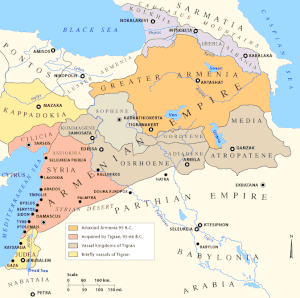Kingdom of Tashir-Dzoraget
Kingdom of Tashir-Dzoraget (Armenian: Տաշիր-Ձորագետի Թագավորություն Tashir-Dzorageti t'agavorut'yun), alternatively known as the Kingdom of Lori or Kiurikian Kingdom by later historians, was a medieval Armenian kingdom formed in the year 979 by the Kiurikian dynasty under the protectorate of the Bagratid kings of Armenia. The capital of the kingdom was Matsnaberd, currently part of modern-day Azerbaijan.
Kingdom of Tashir-Dzoraget Տաշիր-Ձորագետի Թագավորություն | |||||||||
|---|---|---|---|---|---|---|---|---|---|
| 979–1118 | |||||||||
 Kingdom of Tashir-Dzoraget c. 1017 A.D. | |||||||||
| Capital | Matsnaberd (979-1065) Lori (1065-1118) | ||||||||
| Common languages | Armenian | ||||||||
| Religion | Armenian Apostolic Church | ||||||||
| Government | Monarchy | ||||||||
• 979–989 | Kiurike I | ||||||||
• 1089–1118 | David II of Lori | ||||||||
| Historical era | Middle Ages | ||||||||
• Established | 979 | ||||||||
• Kiurike I becomes the first ruler. | 979 | ||||||||
• Disestablished | 1118 | ||||||||
| |||||||||
It was located on the territories of modern-day northern Armenia, northwestern Azerbaijan and southern Georgia. The founder of the kingdom and the Kiurikian dynasty was king Kiurike I (also known as Gurgen I).[1]
In 979 King Smbat II of Armenia granted the province of Tashir to his brother Kiurike with the title of king.[2] The branch went on to outlive the main one in Ani.
It became especially strong during the reign of King David I Anhoghin who succeeded his father Kiurike and ruled between 989 and 1048. David I Anhoghin conquered some territories from Emirates of Tbilisi and Ganja, and chose Samshvilde as his residence. Later on, he tried to gain independence from the Bagratid kings of Ani. However, after failing he was punished by King Gagik I. His properties were confiscated to become known as "Anhoghin" meaning "the Landless." David I was succeeded by Kiurike II who ruled between 1048 and 1089). After the fall of the Bagratid Kingdom of Armenia, Kiurike II was bestowed by the Byzantines with the title of Kouropalates and he became independent ruler.
Kiurike II moved the capital from Matsnaberd to Lori in 1065.
At the peak of its power, kingdom of Tashir-Dzoraget became suzerain of the Emirate of Tiflis[3][4] and the kingdom of Kakheti-Ereti where the branch of Kiurikian dynasty ruled from 1029 to 1105.[5]
In 1089, David II succeeded his father Kiurike II until 1118 when Tashir-Dzoraget was annexed to the Kingdom of Georgia.
After this, the Kiurikians, having strengthened themselves in the fortresses of Tavush, Matsnaberd and Nor-Berd, retained their royal title until the beginning of the 13th century, when Mongols conquered the region [6].
Unlike their Bagratuni relatives, the Kiurikian kings were unique in minting their own coins, with the line, "May the Lord aid Kiurike (George) the Khorapaghat (Kouropalates)," running in five lines inscribed on the reverse side.[7] They sponsored the construction of a number of churches and monasteries in northern Armenia, including those in Sanahin, Haghpat and Haghartsin,[8] where a great many of them were interred.[9]
Gallery
.jpg) Smbat II and his brother Kiurike I depicted at the entrance to Haghpat Monastery
Smbat II and his brother Kiurike I depicted at the entrance to Haghpat Monastery- Akhtala fortress, built by the Kiurinians at the end of the 10th century
- Lori, the 2nd capital of the kingdom
References
- (in Armenian) Matevosyan, Raphael I. (1976). "Տաշիր-Ձորագետը և Հայաստանի Հյուսիս-Արևմտյան Գավառները IX-XI Դարերում," [Tashir-Dzoraget and the north-western regions of Armenia in the ninth to eleventh centuries] in Հայ Ժողովրդի Պատմություն [History of the Armenian People], eds. Tsatur Aghayan et al. Yerevan: Armenian Academy of Sciences, vol. 3, pp. 100-05.
- (in French) Movsesian, Łevond. "Histoire des rois Kurikian de Lori," trans. Frédéric Macler, Revue des Études Arméniennes 7, Pt. 2 (1927), 209ff.
- Artashes Shahnazaryan. Establishment and development of the Kiurikian kingdom of Tashir-Dzoraget(in armenian.)=Տաշիր-Ձորագետի Կյուրիկյան թագավորության առաջացումն ու հզորացումը//Պատմա-Բանասիրական Հանդես: edition.—2009. — Էջ 224—233.—ISSN 0135-0536.
- Jerar Dedeyan//Histoire du peuple arménien(History of the Armenian people)//Publisher «Privat» page. 271, Тuluse 2007—ISBN 978-2-7089-6874-5
- Тumanov Kirill, chapter: «Armenia and Georgia», from: «The Cambridge Medieval History», Cambridge, 1966, vol. IV, pages. 621-622: "The Georgian lands still outside Bagrat IV's realm were the kingdom of Khakhetia and the amirate of Tiflis. In the former, the principate having become hereditary, Kvirike III (1010-29) proclaimed himself king. His daughter was married to David I of Lor'i and their younger son Gagik succeeded in 1029 to Kvirike's throne. The kings of Georgia tried repeatedly to reunite Kakhetia with Iberia; and they, no less than the Kakhetian rulers, made attempts to conquer Tiflis. Bagrat thrice took the city (1046, 1049, 1062), only to lose it again, for his strength was sapped."
- Tashir-Dzoraget kingdom//Great Soviet Encyclopedia:[in 30 vol.]/Ch. ed. A.M. Prokhorov-3rd ed.-M.: Soviet Encyclopedia,1969-1978.
- See Philip Grierson, "Kiurike I or Kiurike II of Loṛi-Armenia?: A Note on Attributions," American Numismatic Society Museum Notes 10 (1958), pp. 107–12.
- Ovannes Ghalpakhtchian and Adriano Alpago-Novello (1970), Sanahin, Milan: Ares.
- Manuk-Khaloyan, Armen, "In the Cemetery of their Ancestors: The Royal Burial Tombs of the Bagratuni Kings of Greater Armenia (890-1073/79)," Revue des Études Arméniennes 35 (2013), p. 168, note 124.

